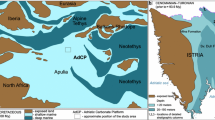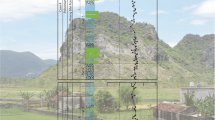Summary
Morphological and geochemical comparisons between modern cryptic microbialites from Lizard Island/Great Barrier Reef and fossil counterparts in the Upper Jurassic (Southern Germany, Dobrogea/Romania) and late Lower Cretaceous (Aptian/Albian from Cantabria/Spain) spongiolitic environments show that there are common factors controlling the crust formations mostly independent of light despite of diverging (paleo-) oceanographic positions as well as relationships of competitors. Factors such as increased alkalinity, oligotrophy, and reduced allochthonous deposition are of major importance. Thrombolitic microbialites are interpreted as biologically induced and therefore calcified in isotopic equilibrium with the surrounding sea water. Corresponding with shallowing upward cycles, microbial mats which produce stromatolitic peloidal crusts become more important. Different biomarkers are introduced for the first time extracted and analyzed from spongiolitic limestones of Lower Kimmeridgian age from Southern Germany.
Similar content being viewed by others
References
Aldinger, H. (1968): Ecology of algal-sponge reefs in the Upper Jurassic of the Schwäbische Alb, Germany.—In:Müller, G. &Zankl, H. (eds.): Recent developments in carbonate sedimentology in central Europe.—250–253, Berlin (Springer)
Andrews, J.E. (1986): Microfacies and geochemistry of Middle Jurassic algal limestones from Scotland.—Sedimentology,33/4, 499–520, Oxford
Bausch, W.M. (1963): Der obere Malm an der unteren Altmühl nebst einer Studie über das Riff-Problem.-Erlanger geol.Abh., 49: 38 p.; Erlangen
Brachert, T. (1986): Kontinuierliche und diskontinuierliche Sedimentation im süddeutschen Oberjura (unteres Kimmeridge; Ludwag/Oberfranken, Nördliche Frankenalb).—Facies,15, 133–284, Erlangen
Brachert, T. &Dullo Ch. (1991): Laminar micrite crusts and associated foreslope processes, Red Sea.—J. Sed. Petrol.,61 (3):354–363, Lawrence
Burne, R.V. &Moore, L.S. (1987): Microbialites: Organosedimentary deposits of benthic microbial communities.— Palaios,2, 241–254, Lawrence
Flügel, E. &Steiger, T. (1981): An Upper Jurassic sponge-algal buildup from the Northern Frankenalb, West Germany.—Soc. Econ. Paleont. Min., Spec.Publ.,30, 371–397, Tulsa
Fritz, G.K. (1958): Schwammstotzen, Tuberolithe und Schuttbreccien im Weißen Jura der Schwäbischen Alb.—Arb. Geol.-Paläont. Inst. TH Stuttgart, N.F.,13, 118 pp., Stuttgart
Gaillard, C. (1983): Les biohermes à spongiaires et leur environment dans l’Oxfordien du Jura Meridional.—Doc. Lab. Géol. Lyon,90, 515 pp., Lyon
Geyer, O.F. (1962): Über Schwammgesteine (Spongiolith, Tuberolith, Spiculit und Gaizit).—Hermann Aldinger Festschrift, 51–66, Stuttgart (chweizerbart)
Gwinner, M. (1976): Origin of the Upper Jurassic of the Swabian Alb.—Contrib. Sedimentol.,5, 1–75, Stuttgart
Gygi, R. (1992): Structure, pattern of distribution and paleobathymetry of Late Jurassic microbialites (stromatolites and oncoids) in northern Switzerland.—Eclogae geol. Helv.,85/3, 799–824, Basel
Gygi, R. &Persoz, F. (1986): Mineralostratigraphy, litho- and biostratigraphy combined in correlation of the Oxfordian (Late Jurassic) formations of the Swiss Jura range.—Eclogae geol. Helv.,79/2, 385–454, Basel
Gygi, R. &Persoz, F. (1987): The epicontinental sea of Swabia (southern Germany) in the Late Jurassic—factors controlling sedimentation.—N. Jb. Geol. Paläont. Abh.,17/1, 49–65, Stuttgart
Hiller, K. (1964): Über die Bank- und Schwammfazies des Weißen Jura der Schwäbischen Alb (Württemberg).—Arb. Geol. Paläont. Inst. TH Stuttgart, N.F.40, 190 pp., Stuttgart
Hummel, P. (1960): Petrographie, Gliederung und Diagenese der Kalke im oberen Weißjura der Schwäbischen Alb.—Arb. Geol. Paläont. Inst. TH Stuttgart, N.F.26, 86 pp., Stuttgart
James, N.P. & Ginsburg, R.N. (1979): The seaward margin of Belize Barrier and Atoll reefs: morphology, sedimentology, organisms distribution and late Quaterny history.—Int. Ass. Sed., Spec. Publ.,3, 191 pp.
Kempe, S. (1990): Alkalinity: the link between anaerobic basins and shallow water carbonates?—Naturwissenschaften,77/4 26–427, Berlin
Keupp, H., Koch, R. &Leinfelder, R. (1990): Steuerungsprozesse der Entwicklung von Oberjura-Spongiolithen Süddeutschlands: Kenntnisstand, Probleme und Perspektiven.—Facies, 23, 141–174, Erlangen
Kott, R. (1989): Fazies und Geochemie des Treuchtlinger Marmors (Unter- und Mittelkimmeridge, Südlichen Frankenalb.),— Berliner geowiss. Abh.,A 111, 115 pp., Berlin
Land, L.S. &Goreau, T.F. (1970): Submarine lithification of Jamaican Reefs.—J. Sed. Petrol.,40, 457–462, Tulsa
Lang, B. (1989): Die Schwamm-Biohermfazies der Nördlichen Frankenalb (Urspring; Oxford, Malm): Mikrofazies, Palökologie Paläontologie.—Facies,20, 199–274, Erlangen
Leinfelder, R. (1992): A Modern-type Kimmeridgian reef (Ota Limestone, Portugal): Implications for Jurassic reef models.— Facies,26, 11–34, Erlangen
Leinfelder, R., Krautter, M. & Werner, W. (1992, unpublished): Vergleichende Palökologie und Faziesentwicklung oberjurassischer Riff-Strukturen des westlichen Tethys-Nordrandes und des Lusitanischen Beckens.—DFG Round Table, Neustadt, 13–14.2 1992
Lohmann, K.C. (1988): Geochemical patterns of meteoric, diagenetic systems and their application to paleokarst.—In:Choquette, P.W. &James, N.P. (eds.): Paleokarst.—58–80; New York (Springer)
Lowenstam, H.A. (1981): Minerals formed by organisms.—Science,211, 1126–1131, Washington
Macintyre, I.G. (1984): Extensive submarine lithification in a cave in the Belize barrier reef platform.—J. Sed. Petrol.54, 221–235, Tulsa
Macintyre, I.G. & Marshall, J.F. (1988): Submarine lithification in coral reefs: some facts and misconceptions.—In: Proc., 5th Intern. Coral Reef Symp., Townsville,2: 1–10, Townsville
McConnaughey, T. (1989):13C and18O isotopic disequilibrium in biological carbonates: II In vitro simulation of kinetic isotope effects.—Geochimica et Cosmochimica Acta,53:163–171, Oxford
Meder, K. (1989): Mikrofazies und Diagenese der Karbonatgesteine des höheren Malms in der Bohrung Saulgau GB 3.—Abh. geol. LA Baden-Württemberg,13, 139–160; Freiberg
Meyer, R.K.F. (1975): Mikrofazielle Untersuchungen in Schwamm-Biohermen und-Biostromen des Malm Epsilon (Ober-Kimmeridge) und obersten Malm Delta der Frankenalb.— Geol. Bl. NO-Bayern,25/4, 149–177, Erlangen
— (1977): Mikrofazies im Übergangsbereich von der Schwammzur Korallen-Spongiomorphiden-Fazies im Malm von Regensburg bis Kelheim.—Geol. Jb.,A 37:33–69, Hannover
— (1978): Massenkalkfazies.—In: Weber, K.: Erläuterungen zur geol. Karte Bayern, 1∶25000, Bl. 7137 Abensberg: 26–38; München (Bayer.geol.LA)
Meyer, R.K.F. &Schmidt-Kaler, H. (1983): Erdgeschichte sichtbar gemacht, Ein geologischer Führer durch die Altmühlalb. —260 pp., München (Bayer. Geol. LA)
Müller, W. (1991): Observations on the Jurassic hexactinellid spongeTremadictyon radicatum (Quenstedt).—In:Reitner, J. &Keupp, H. (eds.): Fossil and Recent Sponges.—36–42; Berlin (Springer)
Neuweiler, F. (1993): Development of Albian microbialites and microbialite reefs (former mud mounds) at platform to basin transitional zones of the Vasco-Cantabrian Basin (Soba reef area, Cantabria, N Spain).—Facies,29, this volume
Nitzopoulos, G. (1974): Faunistisch-ökologische, stratigraphische und sedimentologische Untersuchungen am Schwammstotzen-Komplex bei Spielberg am Hahnenkamm (Ober Oxfordien, Südliche Frankenalb).—Stuttgarter Beitr. Naturkde., Ser. B,16, 143 pp., Stuttgart
Pomoni-Papaioannou, F., Flügel, E. &Koch, R. (1989): Depositional environments and diagenesis of Upper Jurassic subsurface sponge- andTubiphytes reef limestones: Altensteig 1 Well, Western Molasse Basin, Southern Germany.—Facies,21, 263–284, Erlangen
Ponsot, C.M. &Vail, P.R. (1991): Sequence stratigraphy of the Jurassic: New data from the Paris-London Basin.—Abstr. 28 (48), EUG VI Congr., Strassbourg
Rehfeld-Kiefer, U. (1992): Mikrofazies-Entwicklung eines Spongiolith-Körpers in der Kernbohrung 120 (Mittel-Kimmeridge, Eybtal).—Bericht zum DFG-Projekt Ke 322/10-1, Teilprojekt 1: 1–9.—Berlin (unpublished).
Reitner, J. (1987): Mikrofazielle, palökologische und palägeographische Analyse ausgewählter Vorkommen flachmariner Karbonate im Basko-kantabrischen strike slip fault-Becken-System (Nordspanien) an der Wende von der Unterkreide zur Oberkreide.—Documenta Naturae,40, 239 pp.
Reitner, J. (1993): Modern cryptic metazoan/microbialite-community of the Lizard island Section (Great Barrier Reef; Australia)— Telescoped ultraconservative deeper water benthic community with affinities to Tethyan Lower Cretaceous ones.— Facies,29, this volume
Reitner, J. &Keupp, H. (1991): The fossilrecord of the haplosclerid excavating spongeAka de Laubenfelds.—In:Reitner, J. &Keupp, H. (eds.), Fossil and Recent Sponges.—102–120; Berlin (Springer)
Schorr, M. &Koch, R. (1985): Fazieszonierung eines oberjurassischen Algen-Schwamm-Bioherms (Herrlingen, Schwäbische Alb).—Facies,13, 227–270, Erlangen
Stoffers, P. &Botz, R. (1990): Carbonate crusts in the Red Sea: their composition and isotope geochemistry.—In:Ittekot, V., Kempe, S., Michaelis, W. &Spitzy, A., Facets of modern biogeochemistry.—242–252, Berlin (Springer)
Vail, P.R., Mitchum, R.L. &Thompson III, S (1977): Seismic stratigraphy and global changes of sea level.—Part IV: Global cycles and relative changes of sea level.—Amer. Ass. Petrol. Geol. Mem., 26, 83–97, Boulder
Wagenplast, P. (1972): Ökologische Untersuchungen der Fauna aus Bank- und Schwammfazies des Weißen Jura der Schwäbischen Alb.—Arb. Geol. Paläont. Inst. TH Stuttgart, N.F.,67, 99 pp., Stuttgart
Wefer, G. &Berger, W.H. (1991): Isotope paleontology: growth and composition of extant calcareous species.—Marine Geology,100, 207–248, Amsterdam
Wirsing, G. (1988): Mikrofazielle und diagenetische Entwicklung einer oberjurassischen Karbonatabfolge (Weißjura beta bis delta 4, Mittlere Schwäbische Alb) mit Berücksichtigung der chemischen Diagenese ausgewählter karbonatischer Bestandteile. —Heidelberger geowiss Abh.,15, 337+53 pp., Heidelberg
Wirsing, G. &Koch, R. (1986): Algen-Schwamm-Bioherme des Flachwasser-Bereiches (Schwäbische Alb, Weißjura Delta 3).—Facies,14, 285–308, Erlangen
Zankl, H. (1993): Facies29, this volume
Author information
Authors and Affiliations
Rights and permissions
About this article
Cite this article
Keupp, H., Jenisch, A., Herrmann, R. et al. Microbial carbonate crusts-a key to the environmental analysis of fossil spongiolites?. Facies 29, 41–54 (1993). https://doi.org/10.1007/BF02536916
Received:
Accepted:
Issue Date:
DOI: https://doi.org/10.1007/BF02536916




